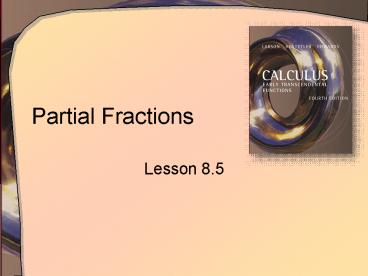Partial Fractions - PowerPoint PPT Presentation
1 / 18
Title:
Partial Fractions
Description:
Example. Combine the Methods. Consider where. P(x), D(x) have no common ... make the rational function easier to integrate. Assignment. Lesson 8.5. Page 559 ... – PowerPoint PPT presentation
Number of Views:119
Avg rating:3.0/5.0
Title: Partial Fractions
1
Partial Fractions
- Lesson 8.5
2
Partial Fraction Decomposition
- Consider adding two algebraic fractions
- Partial fraction decomposition reverses the
process
3
Partial Fraction Decomposition
- Motivation for this process
- The separate terms are easier to integrate
4
The Process
- Given
- Where polynomial P(x) has degree lt n
- P(r) ? 0
- Then f(x) can be decomposed with this cascading
form
5
Strategy
- Given N(x)/D(x)
- If degree of N(x) greater than degree of D(x)
divide the denominator into the numerator to
obtainDegree of N1(x) will be less than that
of D(x) - Now proceed with following steps for N1(x)/D(x)
6
Strategy
- Factor the denominator into factors of the
formwhere is irreducible - For each factor the partial
fraction must include the following sum of m
fractions
7
Strategy
- Quadratic factors For each factor of the form
, the partial fraction
decomposition must include the following sum of n
fractions.
8
A Variation
- Suppose rational function has distinct linear
factors - Then we know
9
A Variation
- Now multiply through by the denominator to clear
them from the equation - Let x 1 and x -1
- Solve for A and B
10
What If
- Single irreducible quadratic factor
- But P(x) degree lt 2m
- Then cascading form is
11
Gotta Try It
- Given
- Then
12
Gotta Try It
- Now equate corresponding coefficients on each
side - Solve for A, B, C, and D
?
13
Even More Exciting
- When but
- P(x) and D(x) are polynomials with no common
factors - D(x) ? 0
- Example
14
Combine the Methods
- Consider where
- P(x), D(x) have no common factors
- D(x) ? 0
- Express as cascading functions of
15
Try It This Time
- Given
- Now manipulate the expression to determine A, B,
and C
16
Partial Fractions for Integration
- Use these principles for the following integrals
17
Why Are We Doing This?
- Remember, the whole idea is tomake the rational
function easier to integrate
18
Assignment
- Lesson 8.5
- Page 559
- Exercises 1 45 EOO

